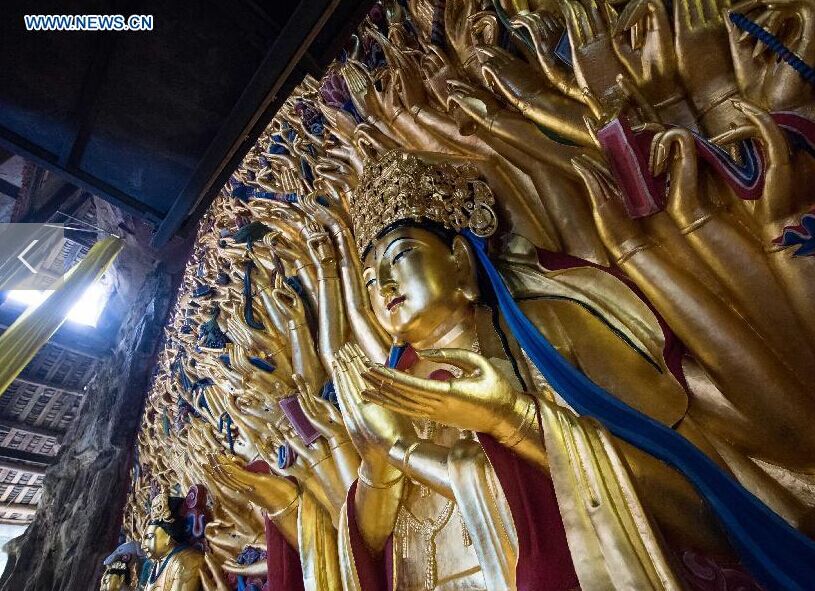- 中文
- EN
- Français
- 日本語
- 한국어
- 繁體中文
Restored Thousand-hand Bodhisattva to Reopen Next Month

The restored Thousand-hand Bodhisattva in all its glory. May 5, 2015 [Photo/Xinhua],
After a seven-year restoration, the statue of Qianshou Guanyin (Thousand-hand Bodhisattva), on Mount Baoding in the Dazu district of Chongqing municipality, will reopen to the public on June 13, Chinese Cultural Heritage Day.
The 7.7-meter high and 12.5-meter wide statue, covered with gold foil and carved in a cave, could date back to the Southern Song Dynasty (1127 to 1279). According to experts the work is the most complete and scientific restoration in more than 800 years.
Over the centuries, Qianshou Guanyin's color had faded, parts of the gold foil had peeled off and cracks appeared. The State Administration of Cultural Heritage placed the sculpture on a protection list in 2008 and launched a restoration project. Involving experts and organizations in the field of historic monuments restoration from China and abroad.
Experts used both traditional Chinese techniques of gilding and lacquer painting as well as X-Ray inspection and other modern scientific methods. Because of the climate in Dazu, the team set up a micro environmental monitoring system, the first time such a system had been used in China.
"Skin protection" was introduced, like a skin cream covering the surface of the Thousand-hand Bodhisattva and conducive to the cleaning the surface.
Experts from the State Cultural Relic Bureau, Sichuan Museum, Dunhuang Academy, Central Academy of Fine Arts, Peking University and the Palace Museum staged a two-day comprehensive examination of the figure of the bodhisattva, or enlightened being, and reached agreement that the cultural heritage center is ready to open.
According to Zhan Changfa, head of the historical relic protection and restoration training center at the Chinese Academy of Culture Heritage, the team conquered all technical difficulties and achieved astonishing results in complicated climate and geographical conditions.
Archaeologists conducted an investigation and study of the "dark cell" or hidden compartment of the sculpture and relics found there. A preliminary investigation discovered that the sealing brick inscription accurately records renovation efforts dating back 200 years, with the words "established in April, the 45th year of Emperor Qianlong's reign".
On fragments removed from the hidden compartment, multi-layer gold leaf and plaster can be identified which are closely related to restoration efforts from different dynasties. Ceramic remnants have a bearing on Buddhism and activities of people from the era.



